Produits
-
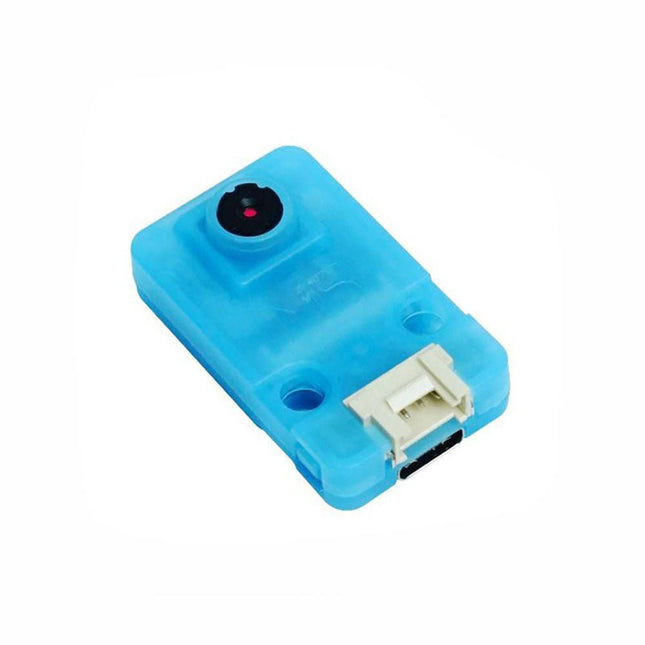
M5Stack Caméra AI M5Stack UnitV K210 pour Edge Computing (OV7740)
Caractéristiques Processeur double cœur RISC-V RV64IMAFDC (RV64GC) 64 bits / 400 MHz (normal) Double FPU indépendant à double précision SRAM sur puce de 8 Mo, 64 bits de largeur Processeur de réseau neuronal (KPU) / 0,8Tops Réseau d'E/S programmable sur site (FPIOA) AES, accélérateur SHA256 Contrôleur d'accès direct à la mémoire (DMAC) Prise en charge des micropythons Prise en charge du cryptage du micrologiciel Matériel embarqué : Flash : 16 M Appareil photo : OV7740 2x Boutons Indicateur d'état LED Stockage externe : carte TF/Micro SD Interface : HY2.0/compatible GROVE Applications Reconnaissance/détection de visage Détection/classification d'objets Obtenez la taille et les coordonnées de la cible en temps réel Obtenez le type de cible détectée en temps réel Reconnaissance de forme Enregistreur vidéo Inclus 1x UNIT-V (comprend un câble 4P de 20 cm et un câble USB-C)
€ 49,95€ 34,95
Membres identique
-
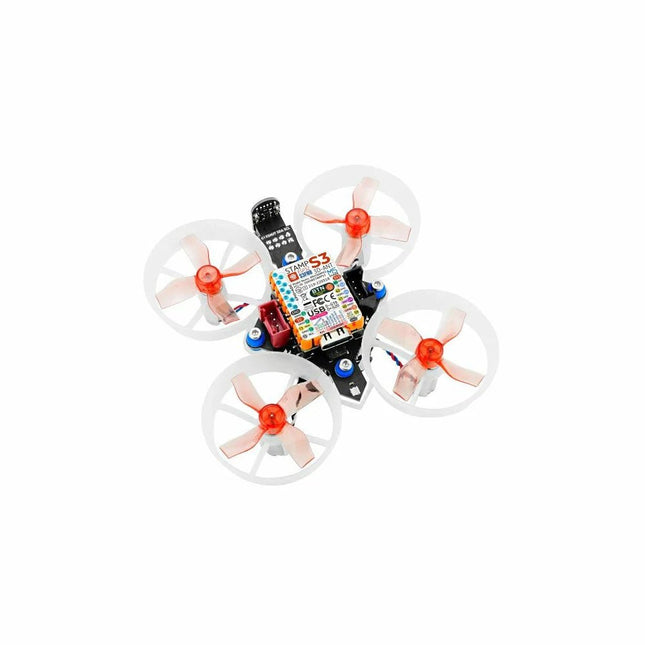
M5Stack M5Stamp Fly Quadcopter (avec M5StampS3)
M5Stamp Fly est un quadricoptère open source programmable, doté du StampS3 comme contrôleur principal. Il intègre un gyroscope 6 axes BMI270 et un magnétomètre 3 axes BMM150 pour la détection d'attitude et de direction. Le capteur de pression barométrique BMP280 et deux capteurs de distance VL53L3 permettent un maintien précis de l'altitude et l'évitement des obstacles. Le capteur de débit optique PMW3901MB-TXQT permet la détection de déplacement. Le kit comprend un buzzer, un bouton de réinitialisation et des LED RVB WS2812 pour l'interaction et l'indication d'état. Il est équipé d'une batterie haute tension de 300 mAh et de quatre moteurs sans noyau à grande vitesse. Le PCB comprend un INA3221AIRGVR pour la surveillance du courant/tension en temps réel et dispose de deux connecteurs Grove pour des capteurs et périphériques supplémentaires. Préchargé avec un firmware de débogage, le Stamp Fly peut être contrôlé à l'aide d'un joystick Atom via le protocole ESP-NOW. Les utilisateurs peuvent choisir entre les modes automatique et manuel, permettant une mise en œuvre facile de fonctions telles que le survol et les retournements précis. Le code source du micrologiciel est open source, ce qui rend le produit adapté à l'éducation, à la recherche et à divers projets de développement de drones. Applications Éducation Recherche Développement de drones Projets de bricolage Caractéristiques M5StampS3 comme contrôleur principal BMP280 pour la détection de la pression barométrique Capteurs de distance VL53L3 pour le maintien d'altitude et l'évitement d'obstacles Capteur d'attitude à 6 axes Magnétomètre à 3 axes pour la détection de direction Détection de flux optique pour la détection de vol stationnaire et de déplacement Sonnerie Batterie haute tension de 300 mAh Détection de courant et de tension Extension du connecteur Grove Spécifications M5StampS3 ESP32-S3@Xtensa LX7, 8 Mo de Flash, WiFi, prise en charge OTG\CDC Moteur 716-17600kv Capteur de distance VL53L3CXV0DH/1 (0x52) à 3 m maximum Capteur de flux optique PMW3901MB-TXQT Capteur barométrique BMP280 (0x76) à 300-1 100 hPa Magnétomètre 3 axes BMM150 (0x10) Capteur IMU 6 axes IMC270 Bosquet I²C+UART Batterie Batterie au lithium haute tension 1S (300 mAh) Détection de courant/tension INA3221AIRGVR (0x40) Sonnerie Buzzer passif intégré @ 5020 Température de fonctionnement 0-40°C Dimensions 81,5 x 81,5 x 31 mm Poids 36,8 g Inclus 1x Stamp Fly 1x Batterie au lithium haute tension de 300 mAh Téléchargements Documentation
€ 79,95€ 59,95
Membres identique
-
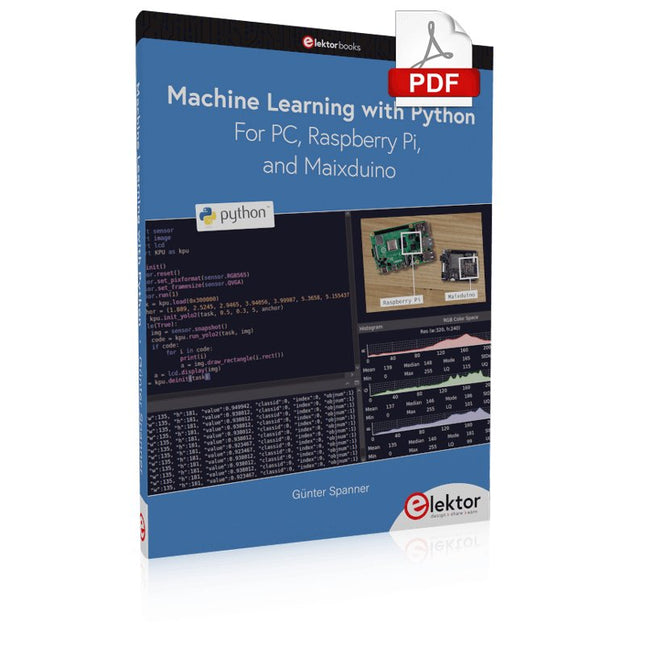
Elektor Digital Machine Learning with Python for PC, Raspberry Pi, and Maixduino (E-book)
La plupart des gens sont de plus en plus confrontés aux applications de l’intelligence artificielle (IA). Les classements de musique ou de vidéo, les systèmes de navigation, les conseils d'achat, etc. reposent sur des méthodes qui peuvent être attribuées à ce domaine. Le terme intelligence artificielle a été inventé en 1956 lors d’une conférence internationale connue sous le nom de Dartmouth Summer Research Project. Une approche fondamentale consistait à modéliser le fonctionnement du cerveau humain et à construire des systèmes informatiques avancés sur cette base. Bientôt, le fonctionnement de l’esprit humain devrait être clair. Le transférer sur une machine n’était considéré qu’une petite étape. Cette notion s'est avérée un peu trop optimiste. Néanmoins, les progrès de l’IA moderne, ou plutôt de sa sous-spécialité appelée Machine Learning (ML), ne peuvent plus être niés. Dans ce livre, plusieurs systèmes différents seront utilisés pour connaître plus en détail les méthodes d’apprentissage automatique. En plus du PC, le Raspberry Pi et le Maixduino démontreront leurs capacités dans les différents projets. Outre des applications telles que la reconnaissance d'objets et de visages, des systèmes pratiques tels que des détecteurs de bouteilles, des compteurs de personnes ou un « œil qui parle » seront également créés. Ce dernier est capable de décrire acoustiquement des objets ou des visages détectés automatiquement. Par exemple, si un véhicule se trouve dans le champ de vision de la caméra connectée, l'information « Je vois une voiture ! est émis via une parole générée électroniquement. De tels appareils sont des exemples très intéressants de la manière dont, par exemple, les personnes aveugles ou gravement malvoyantes peuvent également bénéficier des systèmes d’IA.
€ 32,95
Membres € 26,36
-
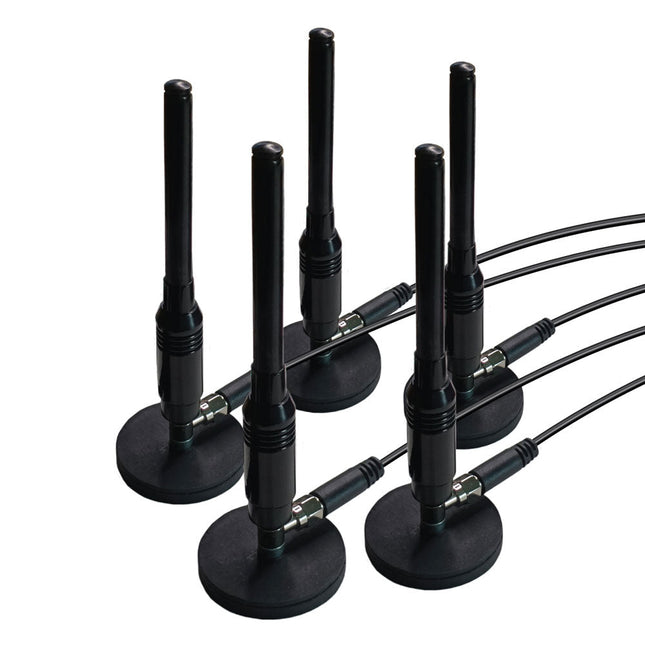
KrakenRF Antennes télescopiques magnétiques pour KrakenSDR (lot de 5)
Un jeu de cinq antennes fouets magnétiques et télescopiques - avec une plage de réglage de 100 MHz à 1 GHz - qui peuvent être utilisées avec KrakenSDR pour la radiogoniométrie. Les aimants sont puissants et se fixent bien sur le toit d'une voiture en mouvement. Comprend un jeu de cinq câbles coaxiaux de deux mètres, équivalents au LMR100, dont la longueur a été adaptée pour de meilleures performances.
€ 259,00€ 219,00
Membres identique
-
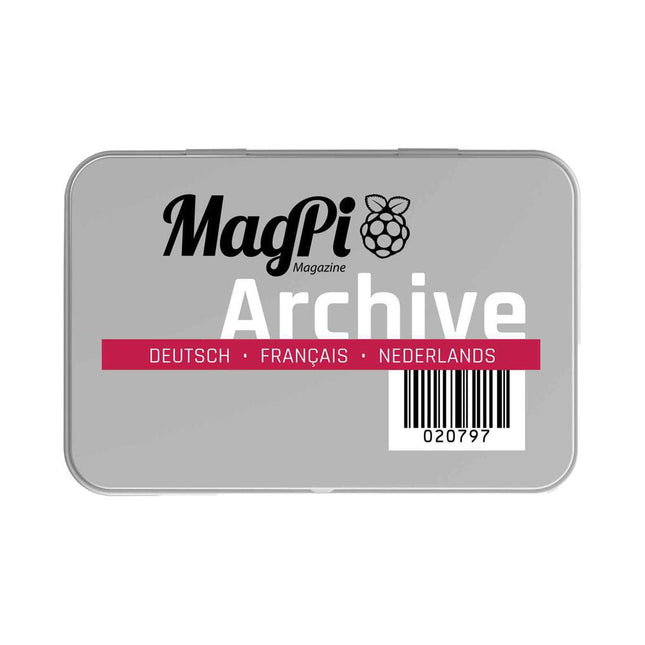
Archives de MagPi sur clé USB
Plus de 6 ans de MagPi (de 2018 à 2024) sur clé USB Cette clé USB contient tous les numéros de MagPi en français des années 2018 à janvier-février 2024. La dernière édition (mars-avril 2024) peut être téléchargée gratuitement pour tout le monde ici. MagPi est le magazine officiel de la Fondation Raspberry Pi. Il contient des bancs d’essai de nouveaux produits, de nombreux tutoriels et un grand nombre de projets choisis pour leur intérêt et leur originalité.
€ 69,95€ 44,95
Membres identique
-
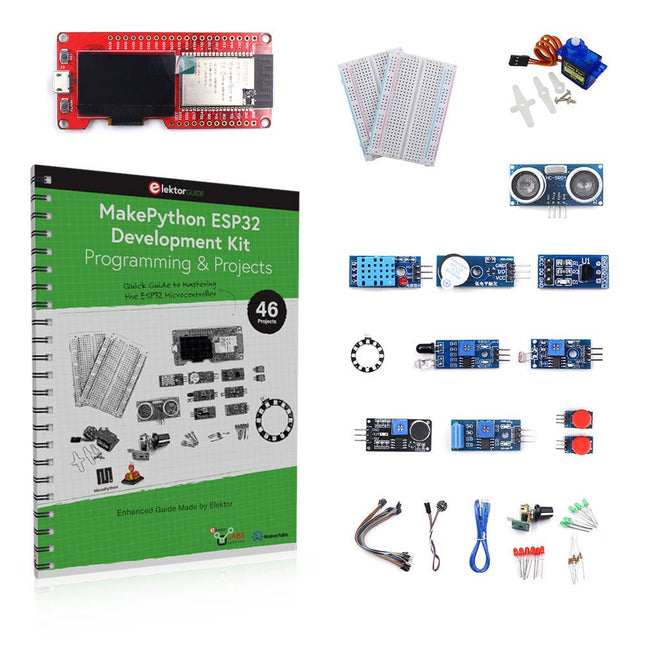
Elektor Bundles MakePython ESP32 Development Kit
Apprenez à utiliser et programmer le microcontrôleur ESP32 en MicroPython dans vos futurs projets ! Ce livre (en anglais) de projets par Dogan Ibrahim, auteur populaire de livres Elektor contient de nombreux projets logiciels et matériels spécialement développés pour le kit de développement ESP32 de MakePython. Le kit est livré avec plusieurs LED, capteurs et actionneurs. Le kit vous aidera à acquérir les connaissances de base pour créer des projets IdO. Les projets testés dans le livre sont basés sur les composants fournis. Chaque projet est décrit par un schéma fonctionnel, un schéma de circuit, un listage complet ainsi qu’une description détaillée du programme. Contenu du kit 1x Carte de développement MakePython ESP32 avec LCD en couleur 1x Module de mesure à ultrasons 1x Capteur de température et d'humidité 1x Module buzzer 1x Module DS18B20 1x Module infrarouge 1x Potentiomètre 1x Module WS2812 1x Capteur de son 1x Capteur de vibrations 1x Module de résistance photosensible 1x Capteur de pouls 1x Servomoteur 1x Câble USB 2x Bouton 2x Plaque d'essai 45x Fils de connexion 10x résistances 330R 10x LED (Rouges) 10x LED (Verts) 1x Livre de projets (en anglais, 206 pages) 46 projets dans le livres Projets à LED LED clignotante SOS clignotant LED clignotante – utilisation d'un timer LED clignotantes en alternance Contrôle des boutons Modification de la fréquence de clignotement des LED à l'aide d'interruptions de boutons-poussoirs LED de poursuite Compteur binaire à LED Lumières de Noël (8 LEDs clignotant de façon aléatoire) Dés électronique Jour de chance de la semaine Projets de modulation de la largeur d'impulsion (PWM) Génération d'une forme d'onde PWM de 1000 Hz avec un rapport cyclique de 50% Contrôle de la luminosité des LED Mesures de la fréquence et du rapport cyclique d'une forme d'onde PWM Compositeur de mélodies Orgue électronique simple Servo motor control Thermomètre DS18B20 à servomoteur Projets de convertisseur analogique-numérique (CAN) Voltmètre Traçage de la tension d'entrée analogique Capteur de température interne de l'ESP32 Ohmmètre Module de résistance photosensible Projets de convertisseur numérique-analogique (CNA) Génération de tensions fixes Génération d'un signal en dents de scie Génération d'un signal à onde triangulaire Forme d'onde périodique arbitraire Génération d'un signal sinusoïdal Génération d'un signal sinusoïdal précis au moyen d'interruptions du timer Utilisation de l'afficheur OLED Compteur de secondes Compteur d'événements Thermomètre numérique à base d'OLED DS18B20 Contrôleur de température ON-OFF Mesure de la température et de l'humidité Mesure de la distance par ultrasons Taille d'une personne (stadiomètre) Mesure de la fréquence cardiaque (pouls) Autres capteurs fournis dans le kit Alarme antivol Lumière activée par le son Détection d'obstacles par infrarouge avec buzzer Anneau de LED RVB WS2812 Horodatage des données de température et d'humidité Programmation réseau Scanner Wi-Fi Contrôle à distance depuis le navigateur Internet (à l'aide d'un smartphone ou d'un PC) – Serveur Web Stockage des données de température et d'humidité dans le cloud Fonctionnement à faible puissance Utilisation d'un timer pour activer le processeur
€ 89,95€ 59,95
Membres identique
-
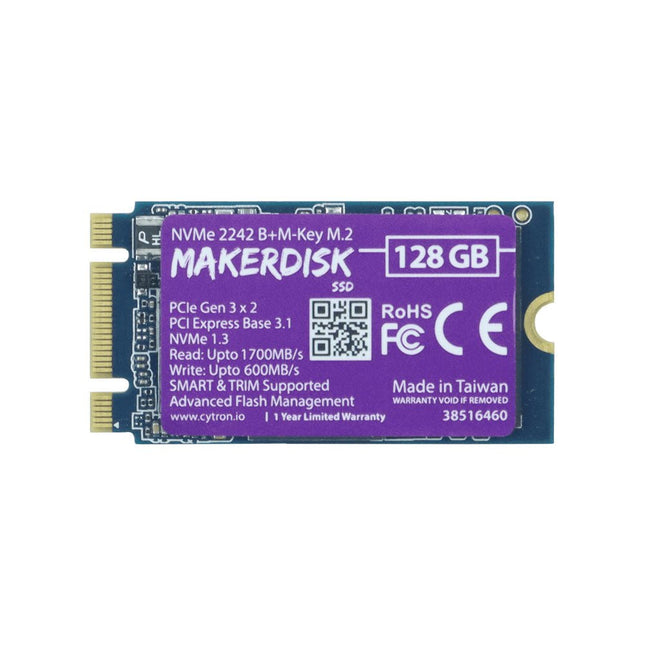
Cytron MakerDisk M.2 SSD avec Raspberry Pi OS préinstallé (128 Go)
Ce SSD NVMe M.2 2242 (128 Go) est livré préinstallé avec le Raspberry Pi OS pour une utilisation immédiate avec le Raspberry Pi 5 M.2 HAT+. Caractéristiques Facteur de forme : SSD NVMe M.2 2242 M-Key Préchargé avec le système d'exploitation Raspberry Pi Haut niveau de capacité à supporter les chocs, les vibrations et les températures élevées Prise en charge de SMART TRIM Interface PCIe : PCIe Gen3 x2 Conformité : NVMe 1.3, PCI Express Base 3.1 Capacité : 128 Go Vitesse : Lecture : jusqu'à 1700 Mo/s Écriture : jusqu'à 600 Mo/s Choc : 1500 G/0,5 ms Température de fonctionnement : 0°C à 70°C Jusqu'à 30 fois plus rapide qu'un disque dur classique Améliore les performances d'écriture en rafale, ce qui le rend idéal pour les charges de travail informatiques classiques Démarrage, arrêt, chargement des applications et réponse plus rapides pour Raspberry Pi Téléchargements Datasheet
€ 49,95€ 37,50
Membres identique
-

Makerfabs Hat 4G LTE pour Raspberry Pi de Makerfabs
Utilisez votre Raspberry Pi avec la communication LTE Cat-4 4G/3G/2G et le positionnement GNSS, pour transmission de données à distance/téléphone/SMS, adapté à la surveillance/alarme de zones éloignées. Ce HAT 4G est basé sur le Maduino Zero 4G LTE, mais sans contrôleur. Il est conçu pour fonctionner avec une Raspberry Pi (connecteur 2 x 20 et USB). La Raspberry communique avec ce HAT avec des commandes AT simples (via les broches TX/RX du connecteur 2 X 20) pour des contrôles simples, tels que SMS/Phone/GNSS ; avec la connexion USB et le pilote Linux approprié installé, le HAT 4G agit comme un adaptateur réseau 4G, qui peut accéder à Internet et transmettre des données avec le protocole 4G. Comparé au dongle USB 4G normal, ce HAT 4G pour Raspberry Pi présente les avantages suivants : Codec audio intégré, qui vous permet d'avoir un appel directement avec votre RPI, ou une diffusion automatique avec un haut-parleur ; Communication UART matérielle, contrôle matériel de l'alimentation (par impulsion de 2 s du GPIO PI ou du bouton POWERKEY), contrôle matériel du mode avion ; Double antenne LTE 4G, plus antenne GPS Caractéristiques LTE Cat-4, avec un débit de liaison montante de 50 Mbps et un débit de liaison descendante de 150 Mbps Positionnement GNSS Pilote audio NAU8810 Prend en charge dial-up, phone, SMS, TCP, UDP, DTMF, HTTP, FTP, etc... Prend en charge GPS, BeiDou, Glonass, Positionnement des stations de base LBS Emplacement pour carte SIM, prend en charge les cartes SIM 1.8 V/3 V Entrée audio intégrée et décodeur audio pour passer un appel téléphonique. 2 indicateurs LED, permettant de surveiller facilement l’état de fonctionnement Prend en charge la boîte à outils d'application SIM : SAT Classe 3, GSM 11.14 Release 99, USAT Inclus 1 Hat 4G LTE pour Raspberry Pi 1 antenne GPS 2 antennes 4G LTE/li> 2 Standoff Téléchargement GitHub
€ 99,95€ 79,95
Membres identique
-
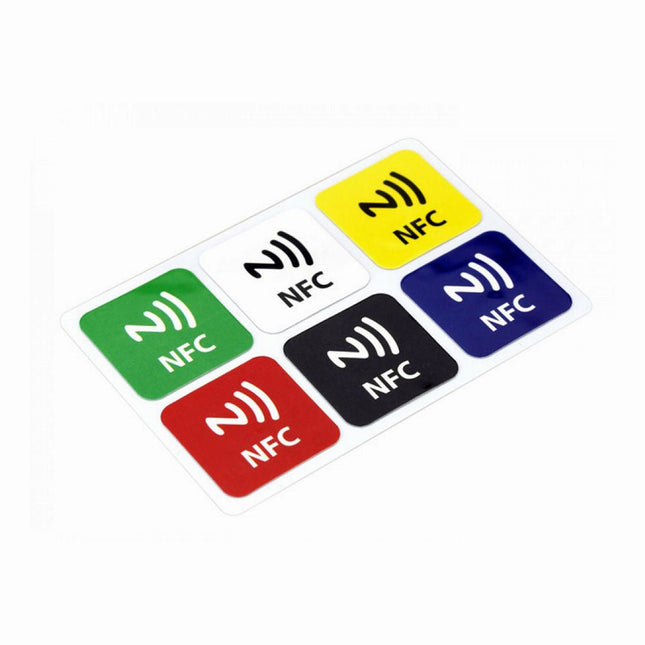
Makerfabs Autocollants NFC Makerfabs (6 pièces)
Caractéristiques Matériau de la puce NFC : PET + antenne de gravure Puce : NTAG216 (compatible avec tous les téléphones NFC) Fréquence : 13,56 MHz (haute fréquence) Temps de lecture : 1 - 2 ms Capacité de stockage : 888 octets Temps de lecture et d'écriture : > 100 000 fois Distance de lecture : 0 - 5 mm Conservation des données : > 10 ans Taille de la puce NFC : Diamètre 30 mm Sans contact, sans friction, le taux de défaillance est faible, faibles coûts de maintenance Taux de lecture, vitesse de vérification, ce qui peut effectivement gagner du temps et améliorer l'efficacité Étanche, anti-poussière, anti-vibration Aucune alimentation n'est fournie avec une antenne, une logique de contrôle de cryptage intégrée et un circuit logique de communication Inclus 1x autocollants NFC (kit 6 couleurs)
€ 9,95
Membres € 8,96
-
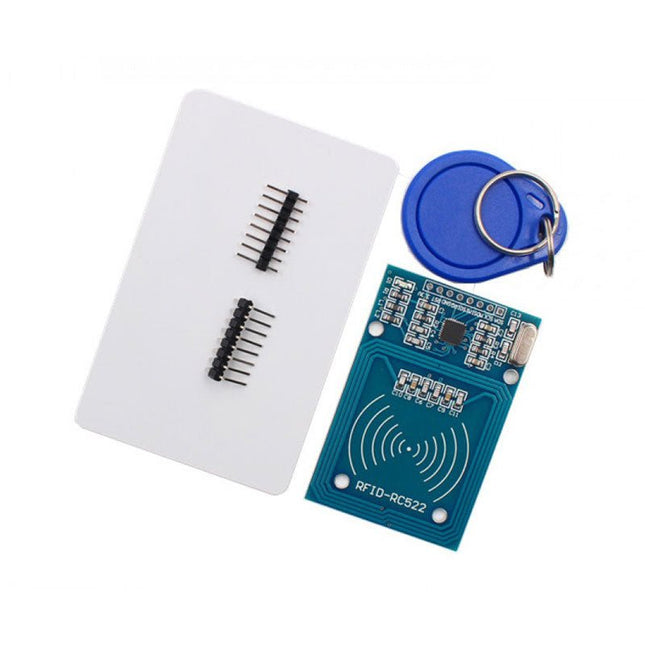
Makerfabs Lecteur RFID RC522 avec kit de cartes (13,56 MHz) de Makerfabs
Ce kit RFID RC522 comprend un module de lecture RF 13,56 MHz qui utilise un circuit intégré RC522 et deux cartes RFID S50 pour vous aider à apprendre et à ajouter la transition RF 13,56 MHz à votre projet. Le MF RC522 est un module de transmission à haute intégration pour la communication sans contact à 13,56 MHz. Le RC522 prend en charge le mode ISO 14443A/MIFARE. Le module utilise la liaison SPI pour communiquer avec les microcontrôleurs. La communauté open-hardware compte déjà de nombreux projets exploitant le RC522 - Communication RFID, avec l'Arduino. Caractéristiques Courant de fonctionnement : 13-26 mA/DC 3,3 V Courant de repos : 10-13 mA/DC 3,3 V Courant de veille : Courant de crête : Fréquence de fonctionnement : 13.56 MHz Types de cartes pris en charge : mifare1 S50, mifare1 S70 MIFARE Ultralight, Mifare Pro, MIFARE DESFire Température ambiante de fonctionnement : -20-80 degrés Celsius Température ambiante de stockage : -40-85 degrés Celsius Humidité relative : humidité relative de 5 % à 95 % Distance de lecture : ≥50 mm/1,95' (Mifare 1) Taille du module : 40×60 mm/1.57*2.34' Paramètre des interfaces du module SPI Taux de transfert de données : 10 Mbit/s maximum Inclus 1x Module RFID-RC522 1x Carte vierge S50 standard 1x Carte S50 format spécial (comme la forme de porte-clés) 1x Broche droite 1x Broche courbée Téléchargements Bibliothèque Arduino Fiche technique duMFRC522 MFRC522_ANT Mifare S50
€ 5,95€ 3,95
Membres identique
-
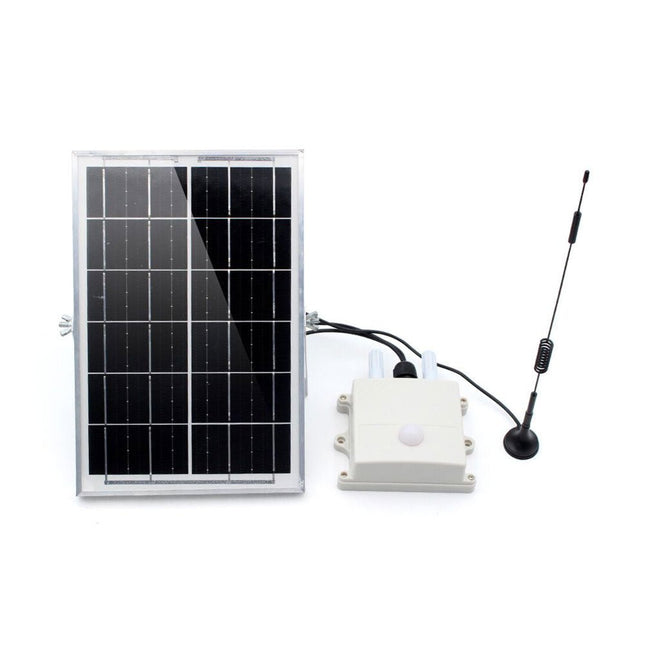
Makerfabs Makerfabs SenseLoRa Industrial-grade Air Monitor (EU868)
This air monitor is specifically used for monitoring greenhouses. It detects: Air temperature & Humidity CO2 concentration Light intensity Then transmit the data via LoRa P2P to the LoRa receiver (on your desk in the room) so that the user can monitor the field status or have it recorded for long-term analysis. This module monitors the greenhouse field status and sends all sensor data regularly via LoRa P2P in Jason format. This LoRa signal can be received by the Makerfabs LoRa receiver and thus displayed/recorded/analyzed on the PC. The monitoring name/data cycle can be set with a phone, so it can be easily implemented into the file. This air monitor is powered by an internal LiPo battery charged by a solar panel and can be used for at least 1 year with the default setting (cycle 1 hour). Features ESP32S3 module onboard with the WiFi and Bluetooth Ready to use: Power it on directly to use Module name/signal interval settable easily by phone IP68 water-proof Temperature: -40°C~80°C, ±0.3 Humidity: 0~100% moisture CO2: 0~1000 ppm Light intensity: 1-65535 lx Communication distance: Lora: >3 km 1000 mAh battery, charger IC onboard Solar panel 6 W, ensure system works Downloads Manual BH1750 Datasheet SGP30 Datasheet
€ 69,95€ 59,95
Membres identique
-

STAEDTLER Marqueurs permanents pour EggBot (Pack de 6)
Feutre universel pour la plupart des surfaces Convient pour la rétroprojection Convient également pour utilisation sur CD et DVD Excellente résistance à l'eau et aux frottements sur la plupart des surfaces Séchage rapide sur le support, idéal pour les gauchers Encre permanente et quasi inodore Encre noire et marron résistante aux U.V. Encre noire résistante aux intempéries Etui chevalet STAEDTLER box Corps et capuchon en polypropylène garantissant une longue durée de vie Encre "DRY SAFE" permettant de laisser décapuchonné plusieurs jours sans sécher (Test ISO 554) Sécurité avion : équilibrage automatique de la pression empêchant l'encre de fuir Encre sans xylène ni toluène Couleurs intenses Pointe superfine 0.4 mm Rechargeable
€ 10,95
Membres € 9,86
-
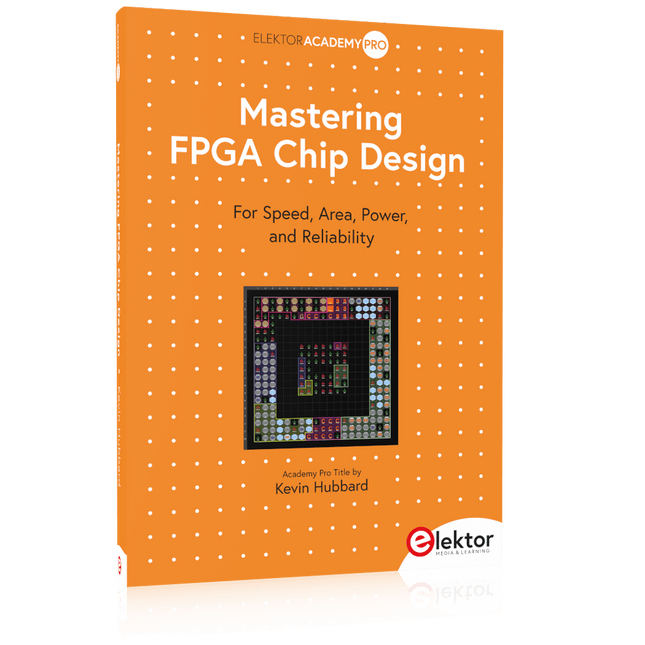
Elektor Publishing Mastering FPGA Chip Design
For Speed, Area, Power, and Reliability This book teaches the fundamentals of FPGA operation, covering basic CMOS transistor theory to designing digital FPGA chips using LUTs, flip-flops, and embedded memories. Ideal for electrical engineers aiming to design large digital chips using FPGA technology. Discover: The inner workings of FPGA architecture and functionality. Hardware Description Languages (HDL) like Verilog and VHDL. The EDA tool flow for converting HDL source into a functional FPGA chip design. Insider tips for reliable, low power, and high performance FPGA designs. Example designs include: Computer-to-FPGA UART serial communication. An open-source Sump3 logic analyzer implementation. A fully functional graphics controller. What you need: Digilent BASYS3 or similar FPGA eval board with an AMD/Xilinx FPGA. Vivado EDA tool suite (available for download from AMD website free of charge). Project source files available from author’s GitHub site.
€ 39,95€ 32,95
Membres identique
-

Elektor Digital Mastering FPGA Chip Design (E-book)
For Speed, Area, Power, and Reliability This book teaches the fundamentals of FPGA operation, covering basic CMOS transistor theory to designing digital FPGA chips using LUTs, flip-flops, and embedded memories. Ideal for electrical engineers aiming to design large digital chips using FPGA technology. Discover: The inner workings of FPGA architecture and functionality. Hardware Description Languages (HDL) like Verilog and VHDL. The EDA tool flow for converting HDL source into a functional FPGA chip design. Insider tips for reliable, low power, and high performance FPGA designs. Example designs include: Computer-to-FPGA UART serial communication. An open-source Sump3 logic analyzer implementation. A fully functional graphics controller. What you need: Digilent BASYS3 or similar FPGA eval board with an AMD/Xilinx FPGA. Vivado EDA tool suite (available for download from AMD website free of charge). Project source files available from author’s GitHub site.
€ 32,95
Membres € 26,36
-

Elektor Publishing Mastering Microcontrollers Helped by Arduino (3rd Edition)
Third, extended and revised edition with AVR Playground and Elektor Uno R4 Arduino boards have become hugely successful. They are simple to use and inexpensive. This book will not only familiarize you with the world of Arduino but it will also teach you how to program microcontrollers in general. In this book theory is put into practice on an Arduino board using the Arduino programming environment. Some hardware is developed too: a multi-purpose shield to build some of the experiments from the first 10 chapters on; the AVR Playground, a real Arduino-based microcontroller development board for comfortable application development, and the Elektor Uno R4, an Arduino Uno R3 on steroids. The author, an Elektor Expert, provides the reader with the basic theoretical knowledge necessary to program any microcontroller: inputs and outputs (analog and digital), interrupts, communication busses (RS-232, SPI, I²C, 1-wire, SMBus, etc.), timers, and much more. The programs and sketches presented in the book show how to use various common electronic components: matrix keyboards, displays (LED, alphanumeric and graphic color LCD), motors, sensors (temperature, pressure, humidity, sound, light, and infrared), rotary encoders, piezo buzzers, pushbuttons, relays, etc. This book will be your first book about microcontrollers with a happy ending! This book is for you if you are a beginner in microcontrollers, an Arduino user (hobbyist, tinkerer, artist, etc.) wishing to deepen your knowledge,an Electronics Graduate under Undergraduate student or a teacher looking for ideas. Thanks to Arduino the implementation of the presented concepts is simple and fun. Some of the proposed projects are very original: Money Game Misophone (a musical fork) Car GPS Scrambler Weather Station DCF77 Decoder Illegal Time Transmitter Infrared Remote Manipulator Annoying Sound Generator Italian Horn Alarm Overheating Detector PID Controller Data Logger SVG File Oscilloscope 6-Channel Voltmeter All projects and code examples in this book have been tried and tested on an Arduino Uno board. They should also work with the Arduino Mega and every other compatible board that exposes the Arduino shield extension connectors. Please note For this book, the author has designed a versatile printed circuit board that can be stacked on an Arduino board. The assembly can be used not only to try out many of the projects presented in this book but also allows for new exercises that in turn provide the opportunity to discover new techniques. Also available is a kit of parts including the PCB and all components. With this kit you can build most of the circuits described in the book and more. Datasheets Active Components Used (.PDF file): ATmega328 (Arduino Uno) ATmega2560 (Arduino Mega 2560) BC547 (bipolar transistor, chapters 7, 8, 9) BD139 (bipolar power transistor, chapter 10) BS170 (N-MOS transistor, chapter 8) DCF77 (receiver module, chapter 9) DS18B20 (temperature sensor, chapter 10) DS18S20 (temperature sensor, chapter 10) HP03S (pressure sensor, chapter 8) IRF630 (N-MOS power transistor, chapter 7) IRF9630 (P-MOS power transistor, chapter 7) LMC6464 (quad op-amp, chapter 7) MLX90614 (infrared sensor, chapter 10) SHT11 (humidity sensor, chapter 8) TS922 (dual op-amp, chapter 9) TSOP34836 (infrared receiver, chapter 9) TSOP1736 (infrared receiver, chapter 9) MPX4115 (analogue pressure sensor, chapter 11) MCCOG21605B6W-SPTLYI (I²C LCD, chapter 12) SST25VF016B (SPI EEPROM, chapter 13) About the author Clemens Valens, born in the Netherlands, lives in France since 1997. Manager at Elektor Labs and Webmaster of ElektorLabs, in love with electronics, he develops microcontroller systems for fun, and sometimes for his employer too. Polyglot—he is fluent in C, C++, PASCAL, BASIC and several assembler dialects—Clemens spends most of his time on his computer while his wife, their two children and two cats try to attract his attention (only the cats succeed). Visit the author’s website: www.polyvalens.com.Authentic testimony of Hervé M., one of the first readers of the book:'I almost cried with joy when this book made me understand things in only three sentences that seemed previously completely impenetrable.'
€ 49,95
Membres € 44,96
-

Elektor Digital Mastering Microcontrollers Helped by Arduino (3rd Edition) | E-book
Third, extended and revised edition with AVR Playground and Elektor Uno R4 Arduino boards have become hugely successful. They are simple to use and inexpensive. This book will not only familiarize you with the world of Arduino but it will also teach you how to program microcontrollers in general. In this book theory is put into practice on an Arduino board using the Arduino programming environment. Some hardware is developed too: a multi-purpose shield to build some of the experiments from the first 10 chapters on; the AVR Playground, a real Arduino-based microcontroller development board for comfortable application development, and the Elektor Uno R4, an Arduino Uno R3 on steroids. The author, an Elektor Expert, provides the reader with the basic theoretical knowledge necessary to program any microcontroller: inputs and outputs (analog and digital), interrupts, communication busses (RS-232, SPI, I²C, 1-wire, SMBus, etc.), timers, and much more. The programs and sketches presented in the book show how to use various common electronic components: matrix keyboards, displays (LED, alphanumeric and graphic color LCD), motors, sensors (temperature, pressure, humidity, sound, light, and infrared), rotary encoders, piezo buzzers, pushbuttons, relays, etc. This book will be your first book about microcontrollers with a happy ending! This book is for you if you are a beginner in microcontrollers, an Arduino user (hobbyist, tinkerer, artist, etc.) wishing to deepen your knowledge,an Electronics Graduate under Undergraduate student or a teacher looking for ideas. Thanks to Arduino the implementation of the presented concepts is simple and fun. Some of the proposed projects are very original: Money Game Misophone (a musical fork) Car GPS Scrambler Weather Station DCF77 Decoder Illegal Time Transmitter Infrared Remote Manipulator Annoying Sound Generator Italian Horn Alarm Overheating Detector PID Controller Data Logger SVG File Oscilloscope 6-Channel Voltmeter All projects and code examples in this book have been tried and tested on an Arduino Uno board. They should also work with the Arduino Mega and every other compatible board that exposes the Arduino shield extension connectors. Please note For this book, the author has designed a versatile printed circuit board that can be stacked on an Arduino board. The assembly can be used not only to try out many of the projects presented in this book but also allows for new exercises that in turn provide the opportunity to discover new techniques. Also available is a kit of parts including the PCB and all components. With this kit you can build most of the circuits described in the book and more. Datasheets Active Components Used (.PDF file): ATmega328 (Arduino Uno) ATmega2560 (Arduino Mega 2560) BC547 (bipolar transistor, chapters 7, 8, 9) BD139 (bipolar power transistor, chapter 10) BS170 (N-MOS transistor, chapter 8) DCF77 (receiver module, chapter 9) DS18B20 (temperature sensor, chapter 10) DS18S20 (temperature sensor, chapter 10) HP03S (pressure sensor, chapter 8) IRF630 (N-MOS power transistor, chapter 7) IRF9630 (P-MOS power transistor, chapter 7) LMC6464 (quad op-amp, chapter 7) MLX90614 (infrared sensor, chapter 10) SHT11 (humidity sensor, chapter 8) TS922 (dual op-amp, chapter 9) TSOP34836 (infrared receiver, chapter 9) TSOP1736 (infrared receiver, chapter 9) MPX4115 (analogue pressure sensor, chapter 11) MCCOG21605B6W-SPTLYI (I²C LCD, chapter 12) SST25VF016B (SPI EEPROM, chapter 13) About the author Clemens Valens, born in the Netherlands, lives in France since 1997. Manager at Elektor Labs and Webmaster of ElektorLabs, in love with electronics, he develops microcontroller systems for fun, and sometimes for his employer too. Polyglot—he is fluent in C, C++, PASCAL, BASIC and several assembler dialects—Clemens spends most of his time on his computer while his wife, their two children and two cats try to attract his attention (only the cats succeed). Visit the author’s website: www.polyvalens.com.Authentic testimony of Hervé M., one of the first readers of the book:'I almost cried with joy when this book made me understand things in only three sentences that seemed previously completely impenetrable.'
€ 34,95
Membres € 27,96
-

Elektor Digital Mastering Surface Mount Technology (E-book)
Mastering Surface Mount Technology takes you on a crash course in techniques, tips and know-how to successfully introduce surface mount technology in your workflow. Even if you are on a budget you too can jumpstart your designs with advanced fine pitch parts. Besides explaining methodology and equipment, attention is given to SMT parts technologies and soldering methods. In a step by step way, several projects introduce you to handling surface mount parts and the required skills to successfully build SMT assemblies. Many practical tips and tricks are disclosed that bring surface mount technology into everyone's reach without breaking the bank.
€ 34,95
Membres € 27,96
-
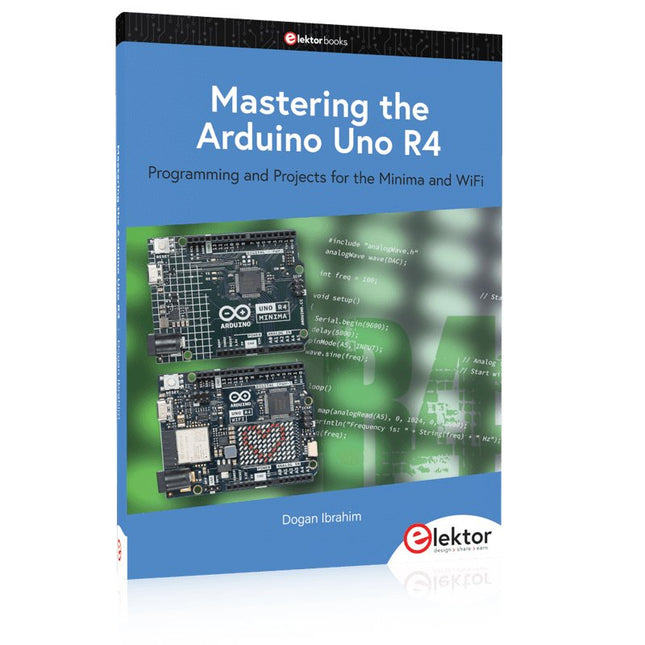
Elektor Publishing Mastering the Arduino Uno R4
Programming and Projects for the Minima and WiFi Based on the low-cost 8-bit ATmega328P processor, the Arduino Uno R3 board is likely to score as the most popular Arduino family member so far, and this workhorse has been with us for many years. Recently, the new Arduino Uno R4 was released, based on a 48-MHz, 32-bit Cortex-M4 processor with a huge amount of SRAM and flash memory. Additionally, a higher-precision ADC and a new DAC are added to the design. The new board also supports the CAN Bus with an interface. Two versions of the board are available: Uno R4 Minima, and Uno R4 WiFi. This book is about using these new boards to develop many different and interesting projects with just a handful of parts and external modules, which are available as a kit from Elektor. All projects described in the book have been fully tested on the Uno R4 Minima or the Uno R4 WiFi board, as appropriate. The project topics include the reading, control, and driving of many components and modules in the kit as well as on the relevant Uno R4 board, including LEDs 7-segment displays (using timer interrupts) LCDs Sensors RFID Reader 4×4 Keypad Real-time clock (RTC) Joystick 8×8 LED matrix Motors DAC (Digital-to-analog converter) LED matrix WiFi connectivity Serial UART CAN bus Infrared controller and receiver Simulators ? all in creative and educational ways with the project operation and associated software explained in great detail.
€ 39,95
Membres € 35,96
-

Elektor Digital Mastering the Arduino Uno R4 (E-book)
Programming and Projects for the Minima and WiFi Based on the low-cost 8-bit ATmega328P processor, the Arduino Uno R3 board is likely to score as the most popular Arduino family member so far, and this workhorse has been with us for many years. Recently, the new Arduino Uno R4 was released, based on a 48-MHz, 32-bit Cortex-M4 processor with a huge amount of SRAM and flash memory. Additionally, a higher-precision ADC and a new DAC are added to the design. The new board also supports the CAN Bus with an interface. Two versions of the board are available: Uno R4 Minima, and Uno R4 WiFi. This book is about using these new boards to develop many different and interesting projects with just a handful of parts and external modules, which are available as a kit from Elektor. All projects described in the book have been fully tested on the Uno R4 Minima or the Uno R4 WiFi board, as appropriate. The project topics include the reading, control, and driving of many components and modules in the kit as well as on the relevant Uno R4 board, including LEDs 7-segment displays (using timer interrupts) LCDs Sensors RFID Reader 4×4 Keypad Real-time clock (RTC) Joystick 8×8 LED matrix Motors DAC (Digital-to-analog converter) LED matrix WiFi connectivity Serial UART CAN bus Infrared controller and receiver Simulators ? all in creative and educational ways with the project operation and associated software explained in great detail.
€ 32,95
Membres € 26,36
-

Elektor Digital Mastering the I²C Bus (E-book)
Mastering the I²C Bus takes you on an exploratory journey of the I²C Bus and its applications. Besides the Bus protocol, plenty of attention is given to the practical applications and designing a stable system. The most common I²C compatible chip classes are covered in detail. Two experimentation boards are available that allow for rapid prototype development. These boards are completed by a USB to I²C probe and a software framework to control I²C devices from your computer. All samples programs can be downloaded from the 'Attachments/Downloads' section on this page. Projects built on Board 1: USB to I²C Interface, PCA 9534 Protected Input, PCA 9534 Protected Output, PCA 9553 PWM LED Controller, 24xxx EEPROM Module, LM75 Temperature Sensor, PCA8563 Real-time Clock with Battery Backup, LCD and Keyboard Module, Bus Power Supply. Projects built on Board 2: Protected Input, Protected Output, LM75 Temperature Sensor, PCF8574 I/O Board, SAA1064 LED Display, PCA9544 Bus Expander, MCP40D17 Potentiometer, PCF8591 AD/DA, ADC121 A/D Converter, MCP4725 D/A Converter, 24xxx EEPROM Module.
€ 34,95
Membres € 27,96
-

Makerfabs MaTouch ESP32-S3 Écran Tactile Rotatif de 2,1" (ST7701)
Cet écran dispose d'une résolution IPS de 480x480 avec un écran tactile capacitif et un taux de rafraîchissement allant jusqu'à 75 FPS. Il est très lumineux et affiche 65 000 couleurs. L'encodeur rotatif mécanique prend en charge la rotation dans le sens horaire et antihoraire, et prend également en charge l'ensemble du processus d'appui, ce qui peut généralement être utilisé pour confirmer le processus. Le module d'affichage est basé sur ESP32-S3 avec WiFi et Bluetooth 5.0 pour une connexion facile à Internet pour les projets IoT. Il peut être alimenté et programmé directement via le port USB. Il dispose également de deux ports d'extension, I²C et UART. Caractéristiques Contrôleur ESP32-S3 WROOM-1-N16R8 (16 Mo de flash, 8 Mo de PSRAM, antenne PCB) Sans fil WiFi et Bluetooth 5.0 Résolution 480x480 Écran LCD IPS LCD de 2,1", 65 000 couleurs Pilote LCD ST7701S Taux de rafraîchissement >70 FPS Interface LCD RGB 565 Panneau tactile Panneau tactile capacitif 5 points Pilote du panneau tactile CST8266 USB USB-C natif Interfaces 1x I²C, 1x UART (connecteur 1,25 mm, 4 broches) Prise en charge d'Arduino Oui Téléchargements Wiki Utilisation avec Squareline/LVGL GitHub Fiche technique ESP32-S3-WROOM-1
€ 64,95€ 54,95
Membres identique
-
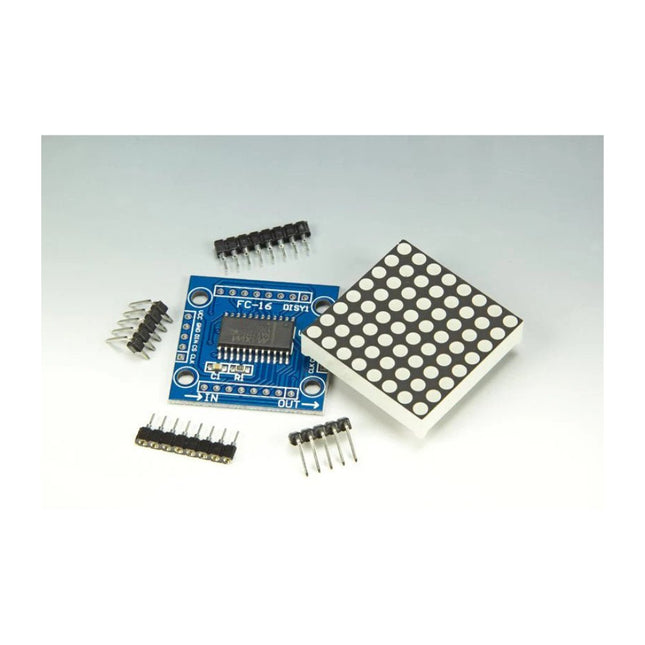
Elektor Labs Module matriciel MAX7219 (jeu de 8)
Affichage de texte déroulant avec huit écrans matriciels LED 8 x 8 (512 LED au total). Construit autour d'un module Wi-Fi ESP-12F (basé sur ESP8266), programmé dans l'IDE Arduino. Le serveur Web ESP8266 permet de contrôler le texte affiché, le délai de défilement et la luminosité avec un téléphone mobile ou un autre appareil (portable) connecté au Wi-Fi. Caractéristiques Interface série 10 MHz Contrôle individuel des segments LED Sélection des chiffres avec décodage/sans décodage Arrêt à faible consommation de 150 µA (données conservées) Contrôle de la luminosité numérique et analogique Affichage masqué à la mise sous tension Affichage LED à cathode commune du lecteur Pilotes de segment limités à taux de rotation pour des EMI inférieurs (MAX7221) Interface série SPI, QSPI, MICROFIL (MAX7221) Boîtiers DIP et SO à 24 broches Remarque : Le circuit imprimé nu pour l'affichage des messages défilants (160491-1) est vendu séparément.
€ 19,95
Membres € 17,96
-
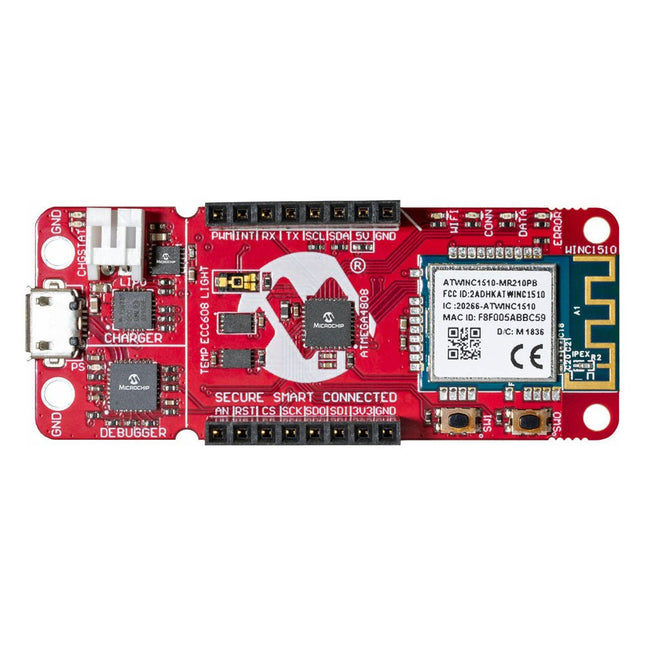
Microchip Carte de développement Microchip AVR-IoT WA
La carte de développement AVR-IoT WA combine un puissant microcontrôleur AVR ATmega4808, un circuit intégré d'élément sécurisé CryptoAuthentication™ ATECC608A et le contrôleur réseau Wi-Fi ATWINC1510 entièrement certifié, qui fournit le moyen le plus simple et le plus efficace de connecter votre application intégrée à Amazon Web Services ( AWS). La carte comprend également un débogueur intégré et ne nécessite aucun matériel externe pour programmer et déboguer le MCU. Prêt à l'emploi, le MCU est préchargé avec une image de micrologiciel qui vous permet de vous connecter et d'envoyer rapidement des données à la plateforme AWS à l'aide des capteurs de température et de lumière intégrés. Une fois que vous êtes prêt à créer votre propre conception personnalisée, vous pouvez facilement générer du code à l'aide des bibliothèques de logiciels gratuits d'Atmel START ou de MPLAB Code Configurator (MCC). La carte AVR-IoT WA est prise en charge par deux environnements de développement intégrés (IDE) primés – Atmel Studio et Microchip MPLAB X IDE – vous donnant la liberté d'innover avec l'environnement de votre choix. Caractéristiques Microcontrôleur ATmega4808 Quatre LED utilisateur Deux boutons mécaniques Empreinte de l'en-tête mikroBUS Capteur de lumière TEMT6000 Capteur de température MCP9808 Dispositif CryptoAuthentication™ ATECC608A Module Wi-Fi WINC1510 Débogueur intégré Auto-ID pour l'identification de la carte dans Atmel Studio et Microchip MPLAB Une LED verte d'alimentation et d'état de la carte Programmation et débogage Port COM virtuel (CDC) Deux lignes DGI GPIO Alimenté par USB et par batterie Chargeur de batterie Li-Ion/LiPo intégré
€ 39,95€ 29,95
Membres identique
-
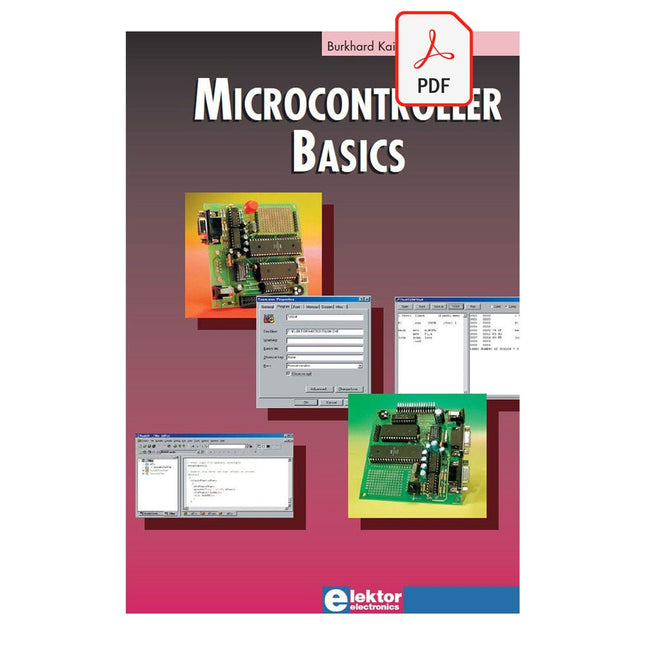
Elektor Digital Microcontroller Basics (E-book)
Microcontrollers have become an indispensable part of modern electronics. They make things possible that vastly exceed what could be done previously. Innumerable applications show that almost nothing is impossible. There’s thus every reason to learn more about them, but that raises the question of where to find a good introduction to this fascinating technology. The answer is easy: this Microcontroller Basics book, combined with the 89S8252 Flash Board project published by Elektor Electronics. However, this book offers more than just a basic introduction. It clearly explains the technology using various microcontroller circuits and programs written in several different programming languages. Three microcontrollers from the 8051 family are used in the sample applications, ranging from the simple 89C2051 to the AN2131, which is designed to support USB applications. The programming tools include assemblers, Basic-52 and BASCOM-51, and several C compilers. Every reader can thus find the programming environment most suitable to his or her needs. In the course of the book, the reader gradually develops increased competence in converting his or her ideas into microcontroller circuitry. All of the sample programs can be downloaded from the Elektor Electronics website or the author’s website. That has the added advantage that the latest versions are always available.
€ 19,95
Membres € 15,96























